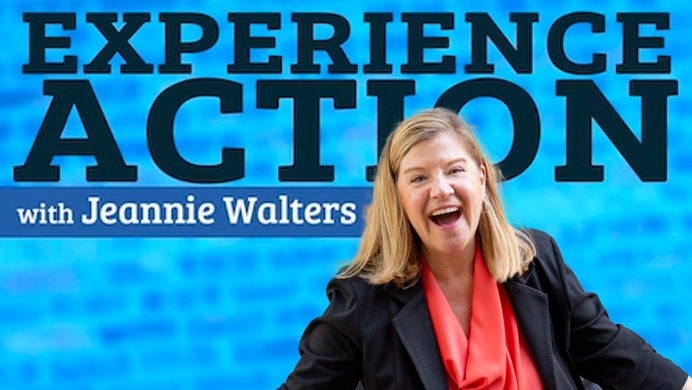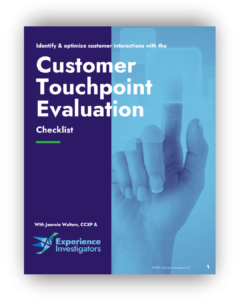An intentional, proactive customer experience (CX) has unmatched power for attracting new customers and earning their lifelong loyalty. But this is easy to say and harder to do. To really deliver for your customers and your organizational goals — and achieve scalable growth by operationalizing CX — you need a calculated CX strategy.
People today have countless options for where to shop and how to solve their challenges. Customer experience can be a differentiator to attract these shoppers. So CX leaders like you need to reach customers in personalized ways on the channels they use most if you want to break through the noise. And once you have their attention, every step in their journey can deepen their loyalty — or cause them to look elsewhere.
There are so many places you can focus. Everyone in your organization has the power to create great experiences, but it takes a strategic effort to make the most use of your time and scale your efforts successfully.
This article offers a step-by-step approach to creating your CX strategy — from setting a vision to implementing and refining your plan — to empower you to turn CX into a true revenue generator for your organization.
Ready to set up for success? Let’s dig in.
Every department or business function needs a strategy. Customer experience is no exception.
Your CX strategy should reflect where your organization currently stands with its customer experience and define a clear vision for where you can go next. A well-defined CX strategy can help you drive tangible business outcomes: Greater customer retention, a stronger brand reputation, and faster revenue generation.
Of course, these won’t happen overnight. The strategy explains every step you’ll take so you know where to focus, how to measure your success, and gradually expand your footprint.
A well-built CX strategy involves a few critical elements. Each of these plays a distinct role in your efforts and helps you align every member of your organization so you can operationalize CX effectively:
To create your CX strategy elements and guide your daily efforts, follow these five steps:
Start with your foundation. Define the CX Strategy elements we explored above, including a customer-centric vision statement and measurable CX goals.
Why are you starting on this journey of customer experience? What do you believe it will do for your business outcomes and customers? Your vision might be broad — like creating a customer experience that is a differentiator — but that’s not enough to set up for success. That’s why we recommend a CX Mission Statement to concisely state what you’re doing for customers and what everyone in your organization should understand as your mission.
Your vision and, ultimately, your CX Mission Statement will guide the entire CX strategy, and the best strategies align with your overarching business goals.
Goalsetting is a crucial step. (And ironically, one of the most overlooked in CX!) Remember, your customers are having a customer experience whether you define it or not. That’s why being intentional is so vital to a successful program.
Be transparent about where your customer experience is today and what you can accomplish in a clearly defined timeframe. You may aspire to accomplish many things with your CX program. I often hear about common goals like:
The Experience Investigators team uses SMIRC goals for CX: Social, measurable, inspiring, relevant, and contextual. SMIRC goals make each of your aspirations more tangible, so you know exactly what you’re working toward:
Each of the above examples includes CX metrics you may choose to track. However, a quick word of advice: Any metric can give you some insight into your success, but no metric is worth your sole attention. Measurement should include both customer feedback data AND operational data. (Have questions? Here’s a resource.)

Keep an eye on your metrics, but don’t obsess over them and fall into the trap of overmeasuring your results. Set a clear cadence for which you’ll measure, and pay some attention to any metric you can access so you don’t miss key indicators of where you may want to focus. Remember, metrics themselves are never outcomes. They are measurements of what outcomes you want!
Related resources: Download our free CX Mission Statement Workbook and CX Success Strategy Statement Workbook.


With your vision and goals set, it’s time to get to know your customers. (After all, they’re the people you’re helping!)
Customer personas represent customers in groups of shared attributes. Personas help you envision real peoples’ thoughts, feelings, and preferences so you address every group’s unique needs as you execute your strategy.
Personas may be fairly general at first, which is okay. Build personas around the key differentiators between groups — such as tech-savvy millennials who value convenience and personalized service, or safety-focused parents who prioritize trust and knowledgeable support — and get more granular as your intelligence grows.
And keep in mind that people are people, not personas. Personas are a tool to help us get closer to our customers, but no person behaves exactly the same way all the time. There are good reasons for personas — but they are tools, not mandates. Be careful about assuming your persona is the one representative you need. Keep listening to customers and watching behaviors to really understand their nuances and differences. Personas are powerful tools, so don’t be afraid to experiment with how you track behaviors and create these groups.
A bank’s customer personas may look something like this:
A clothing retailer may rely on more detailed customer personas, like the following:
Ongoing customer listening efforts help you improve your personas and journey maps and understand which touchpoints may be most important to prioritize for each group. Surveys, interviews, and feedback forms all provide insights and improve your understanding of the CX metrics you’re following. Be sure to listen for untold customer feedback, too.
You don’t have to build your customer personas alone. Artificial intelligence (AI) is incredibly powerful at analyzing large volumes of data to identify trends and key differences between groups you should be aware of.
Even if you have a pretty good understanding of your customers, AI can help validate your knowledge, enrich your persona details, and uncover new areas to consider.
Follow these steps to have AI build or enrich your customer personas:
Customer journey mapping exercises will enmesh you in each persona’s journey to understand how they find you, what they seek at key steps of their shopping journey (also known as customer touchpoints), and how you can maximize their post-purchase satisfaction.
Related resource: Customer Journey Mapping Examples: 4 Use Cases to Inform Your CX Strategy.

Evaluate each customer touchpoint for its consistency with your customer experience vision and whether it effectively meets your customer’s needs. There are a lot of areas you can focus, so focus on one channel at a time and first prioritize areas most relevant to your goals. This can include channels or common journeys like:
For example: If customer churn is high for new customers and your customer feedback shows that the onboarding process is lengthy and complicated, consider creating tutorials or onboarding videos to guide customers through that process. Monitor for a decrease in customer churn during their first months and an increase in total customer lifetime value to see if your efforts are paying off.
This is another opportunity to use AI to your advantage and suggest which customer touchpoints are most critical to the overall experience and supporting your organization’s goals.
 Are your customer interactions driving loyalty or losing business? Are your customer interactions driving loyalty or losing business?
Use our Customer Touchpoint Evaluation Checklist to identify gaps and improve every stage of your customer journey! |
Every member of your organization plays an important role in shaping and reinforcing your customer experience (whether they realize it or not).
Aligning CX and customer service is often considered given the direct overlap, however, customer service isn’t the only area to focus on.
The most successful CX teams align every department around the CX mission and foster collaboration across marketing, sales, support, and technology teams to ensure consistent CX. Your strategy for building this alignment will partially depend on where CX lives in your organization, but there are several ways to drive ongoing alignment:
Meet with cross-departmental leaders regularly to discuss their goals and how a great CX will help their team thrive. It helps to start with one or two departments whose leaders have previously shown support for CX. This way, you can drive some immediate benefits and demonstrate to other leaders how CX can help them.
Measuring your results is essential to see the impact of your efforts and demonstrate the actual business value CX creates.
Your Customer Experience Success Strategy Statement should give your measurement based on the metrics you identified. You need some way to measure those metrics and communicate your results to organizational leaders.
Many CX management tools can provide you with in-depth reporting capabilities, including Medallia and Qualtrics, and you can couple those insights with information from Google Analytics to get a deeper understanding of how people interact with your website and content.
Related resource: Customer Experience ROI: Tying CX Investments to Business Success

Ongoing measurement, customer listening, and evaluation help you understand what is and isn’t working so you can adjust your strategy accordingly:
A customer advisory board (CAB) can help many organizations access customers who are willing to share their thoughts and feedback regularly. Running a CAB requires initial setup and ongoing investment, which you may not be able to focus on right now.
At a minimum, follow a quarterly cadence where you revisit your CX Mission Strategy, assess your metrics, and reflect on what is or isn’t working. You may decide it’s appropriate to shift course mid-year, which gives you time to get on a better path and still drive measurable results before the end of the year.
It’s not enough for organizations to say they are “customer-obsessed” or “prioritize the customer in everything we do.”
A strong customer experience strategy enables you to create a truly customer-centric brand. No matter where you are in your customer experience journey, the CX strategy will provide the direction you need to drive meaningful improvements and prove your results to executives.
Stay committed to your strategy and be willing to shift course as new opportunities arise or as your customer expectations evolve. Every action you take has the potential to make someone’s life easier and help them thrive. It’s a uniquely rewarding opportunity, isn’t it?
To gain ongoing guidance, tips, and strategies to keep evolving your CX strategy, check out these resources:
If you are looking for expert guidance in building your strategy or guiding your day-to-day efforts, hiring a customer experience consultant can quickly accelerate your CX success. Learn more about how a CX business partner can help your organization, and start a conversation with me here to see how Experience Investigators can move your program forward.
 Jeannie is an award-winning customer experience expert, international keynote speaker, and sought-after business coach who is trailblazing the movement from “Reactive Customer Service” to “Proactive Customer and Employee Experience.” More than 500,000 people have learned from her CX courses on LinkedIn Learning, and her insights have been featured in Forbes, The Chicago Tribune, The Wall Street Journal and NPR.
Get Jeannie’s insights in your inbox each week by subscribing to The Weekly Win and follow her on LinkedIn, Instagram and YouTube.
Jeannie is an award-winning customer experience expert, international keynote speaker, and sought-after business coach who is trailblazing the movement from “Reactive Customer Service” to “Proactive Customer and Employee Experience.” More than 500,000 people have learned from her CX courses on LinkedIn Learning, and her insights have been featured in Forbes, The Chicago Tribune, The Wall Street Journal and NPR.
Get Jeannie’s insights in your inbox each week by subscribing to The Weekly Win and follow her on LinkedIn, Instagram and YouTube.